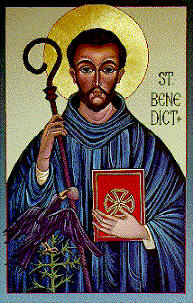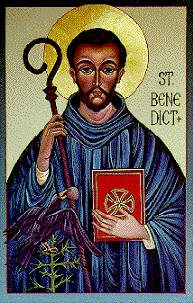Roman Catholic Saint and Founder of the Benedictine Monastic Order. The only ancient account of his life is contained in the 2nd volume of Pope Gregory I's (Pope Gregory the Great) four-book "Dialogues," believed to have been written in 593 A.D.
Benedict was the son of a Roman noble of Nursia, now known as Norcia, in the southern region of Umbria of the Perugia province in Italy. He had a twin sister, Scholastica, who became a nun (and ultimately a saint). According to tradition, he became disillusioned with his life and the immorality of society in Rome, abandoned his studies, and left his home around 500 A.D., travelling to Enfide (now Affile) to associate with others who shared his views of life.
While walking in the mountains near Enfide, he met a monk, Romanus of Subiaco, in a cave whose monastery was on the mountain above the cliff that overhung the cave. Romanus advised him to become a hermit at this cave, which he did for three years, and was frequently ministered to by Romanus. During this time, he matured in mind and character, securing the respect of the community around him.
When the abbot of a local monastery died, he was asked by the local community to become its new abbot. He finally consented, knowing that their ways were diverse from his and that they would probably never agree on anything. The experiment failed. The monks thought him too strict and attempted to poison him. According to legend, they first attempted to poison his drink; when he prayed a blessing over the cup, it shattered. They then poisoned his bread; when he blessed it, a raven swept down and took it away.
He returned to his cave. Miracles seem to become more frequent and many people, who were attracted to his sanctity and character, came to Subiaco to be under his teachings and guidance. He founded 12 monasteries in the vicinity of Subiaco and eventually founded the great Benedictine monastery of Monte Cassino in 529 A.D., which lies on a hilltop between Rome and Naples, Italy. It is here that he wrote his "Rule of Saint Benedict," a book of precepts for monks who live communally under the authority of an abbot.
He died of a high fever at Monte Cassino at the age of 67, not long after his twin sister died, and they were buried in the same place. In 1220, he was canonized by Pope Honorius III. He was named patron protector of Europe by Pope Paul VI in 1964, and, in 1980, Pope John Paul II declared him co-patron of Europe, together with Saints Cyril and Methodius. Prior to 1970, his feast day was March 21, but because it falls during the season of Lent, the reform of the General Roman calendar transferred the obligatory memorial for him to July 11. The Saint Benedict Medal was first struck in 1880 to commemorate the fourteenth centenary of his birth.
Roman Catholic Saint and Founder of the Benedictine Monastic Order. The only ancient account of his life is contained in the 2nd volume of Pope Gregory I's (Pope Gregory the Great) four-book "Dialogues," believed to have been written in 593 A.D.
Benedict was the son of a Roman noble of Nursia, now known as Norcia, in the southern region of Umbria of the Perugia province in Italy. He had a twin sister, Scholastica, who became a nun (and ultimately a saint). According to tradition, he became disillusioned with his life and the immorality of society in Rome, abandoned his studies, and left his home around 500 A.D., travelling to Enfide (now Affile) to associate with others who shared his views of life.
While walking in the mountains near Enfide, he met a monk, Romanus of Subiaco, in a cave whose monastery was on the mountain above the cliff that overhung the cave. Romanus advised him to become a hermit at this cave, which he did for three years, and was frequently ministered to by Romanus. During this time, he matured in mind and character, securing the respect of the community around him.
When the abbot of a local monastery died, he was asked by the local community to become its new abbot. He finally consented, knowing that their ways were diverse from his and that they would probably never agree on anything. The experiment failed. The monks thought him too strict and attempted to poison him. According to legend, they first attempted to poison his drink; when he prayed a blessing over the cup, it shattered. They then poisoned his bread; when he blessed it, a raven swept down and took it away.
He returned to his cave. Miracles seem to become more frequent and many people, who were attracted to his sanctity and character, came to Subiaco to be under his teachings and guidance. He founded 12 monasteries in the vicinity of Subiaco and eventually founded the great Benedictine monastery of Monte Cassino in 529 A.D., which lies on a hilltop between Rome and Naples, Italy. It is here that he wrote his "Rule of Saint Benedict," a book of precepts for monks who live communally under the authority of an abbot.
He died of a high fever at Monte Cassino at the age of 67, not long after his twin sister died, and they were buried in the same place. In 1220, he was canonized by Pope Honorius III. He was named patron protector of Europe by Pope Paul VI in 1964, and, in 1980, Pope John Paul II declared him co-patron of Europe, together with Saints Cyril and Methodius. Prior to 1970, his feast day was March 21, but because it falls during the season of Lent, the reform of the General Roman calendar transferred the obligatory memorial for him to July 11. The Saint Benedict Medal was first struck in 1880 to commemorate the fourteenth centenary of his birth.
Bio by: William Bjornstad
Advertisement




